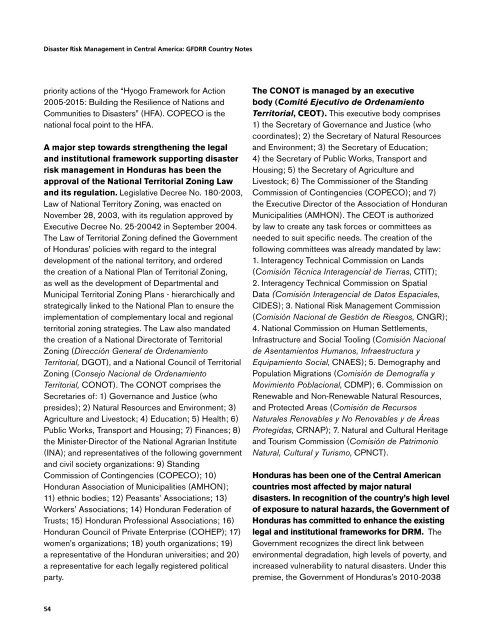Disaster Risk Management in Central America: GFDRR Country Notes
Disaster Risk Management in Central America: GFDRR Country Notes
Disaster Risk Management in Central America: GFDRR Country Notes
You also want an ePaper? Increase the reach of your titles
YUMPU automatically turns print PDFs into web optimized ePapers that Google loves.
<strong>Disaster</strong> <strong>Risk</strong> <strong>Management</strong> <strong>in</strong> <strong>Central</strong> <strong>America</strong>: <strong>GFDRR</strong> <strong>Country</strong> <strong>Notes</strong><br />
priority actions of the “Hyogo Framework for Action<br />
2005-2015: Build<strong>in</strong>g the Resilience of Nations and<br />
Communities to <strong>Disaster</strong>s” (HFA). COPECO is the<br />
national focal po<strong>in</strong>t to the HFA.<br />
A major step towards strengthen<strong>in</strong>g the legal<br />
and <strong>in</strong>stitutional framework support<strong>in</strong>g disaster<br />
risk management <strong>in</strong> Honduras has been the<br />
approval of the National Territorial Zon<strong>in</strong>g Law<br />
and its regulation. Legislative Decree No. 180-2003,<br />
Law of National Territory Zon<strong>in</strong>g, was enacted on<br />
November 28, 2003, with its regulation approved by<br />
Executive Decree No. 25-20042 <strong>in</strong> September 2004.<br />
The Law of Territorial Zon<strong>in</strong>g def<strong>in</strong>ed the Government<br />
of Honduras’ policies with regard to the <strong>in</strong>tegral<br />
development of the national territory, and ordered<br />
the creation of a National Plan of Territorial Zon<strong>in</strong>g,<br />
as well as the development of Departmental and<br />
Municipal Territorial Zon<strong>in</strong>g Plans - hierarchically and<br />
strategically l<strong>in</strong>ked to the National Plan to ensure the<br />
implementation of complementary local and regional<br />
territorial zon<strong>in</strong>g strategies. The Law also mandated<br />
the creation of a National Directorate of Territorial<br />
Zon<strong>in</strong>g (Dirección General de Ordenamiento<br />
Territorial, DGOT), and a National Council of Territorial<br />
Zon<strong>in</strong>g (Consejo Nacional de Ordenamiento<br />
Territorial, CONOT). The CONOT comprises the<br />
Secretaries of: 1) Governance and Justice (who<br />
presides); 2) Natural Resources and Environment; 3)<br />
Agriculture and Livestock; 4) Education; 5) Health; 6)<br />
Public Works, Transport and Hous<strong>in</strong>g; 7) F<strong>in</strong>ances; 8)<br />
the M<strong>in</strong>ister-Director of the National Agrarian Institute<br />
(INA); and representatives of the follow<strong>in</strong>g government<br />
and civil society organizations: 9) Stand<strong>in</strong>g<br />
Commission of Cont<strong>in</strong>gencies (COPECO); 10)<br />
Honduran Association of Municipalities (AMHON);<br />
11) ethnic bodies; 12) Peasants’ Associations; 13)<br />
Workers’ Associations; 14) Honduran Federation of<br />
Trusts; 15) Honduran Professional Associations; 16)<br />
Honduran Council of Private Enterprise (COHEP); 17)<br />
women’s organizations; 18) youth organizations; 19)<br />
a representative of the Honduran universities; and 20)<br />
a representative for each legally registered political<br />
party.<br />
The CONOT is managed by an executive<br />
body (Comité Ejecutivo de Ordenamiento<br />
Territorial, CEOT). This executive body comprises<br />
1) the Secretary of Governance and Justice (who<br />
coord<strong>in</strong>ates); 2) the Secretary of Natural Resources<br />
and Environment; 3) the Secretary of Education;<br />
4) the Secretary of Public Works, Transport and<br />
Hous<strong>in</strong>g; 5) the Secretary of Agriculture and<br />
Livestock; 6) The Commissioner of the Stand<strong>in</strong>g<br />
Commission of Cont<strong>in</strong>gencies (COPECO); and 7)<br />
the Executive Director of the Association of Honduran<br />
Municipalities (AMHON). The CEOT is authorized<br />
by law to create any task forces or committees as<br />
needed to suit specific needs. The creation of the<br />
follow<strong>in</strong>g committees was already mandated by law:<br />
1. Interagency Technical Commission on Lands<br />
(Comisión Técnica Interagencial de Tierras, CTIT);<br />
2. Interagency Technical Commission on Spatial<br />
Data (Comisión Interagencial de Datos Espaciales,<br />
CIDES); 3. National <strong>Risk</strong> <strong>Management</strong> Commission<br />
(Comisión Nacional de Gestión de Riesgos, CNGR);<br />
4. National Commission on Human Settlements,<br />
Infrastructure and Social Tool<strong>in</strong>g (Comisión Nacional<br />
de Asentamientos Humanos, Infraestructura y<br />
Equipamiento Social, CNAES); 5. Demography and<br />
Population Migrations (Comisión de Demografía y<br />
Movimiento Poblacional, CDMP); 6. Commission on<br />
Renewable and Non-Renewable Natural Resources,<br />
and Protected Areas (Comisión de Recursos<br />
Naturales Renovables y No Renovables y de Áreas<br />
Protegidas, CRNAP); 7. Natural and Cultural Heritage<br />
and Tourism Commission (Comisión de Patrimonio<br />
Natural, Cultural y Turismo, CPNCT).<br />
Honduras has been one of the <strong>Central</strong> <strong>America</strong>n<br />
countries most affected by major natural<br />
disasters. In recognition of the country’s high level<br />
of exposure to natural hazards, the Government of<br />
Honduras has committed to enhance the exist<strong>in</strong>g<br />
legal and <strong>in</strong>stitutional frameworks for DRM. The<br />
Government recognizes the direct l<strong>in</strong>k between<br />
environmental degradation, high levels of poverty, and<br />
<strong>in</strong>creased vulnerability to natural disasters. Under this<br />
premise, the Government of Honduras’s 2010-2038<br />
54
















